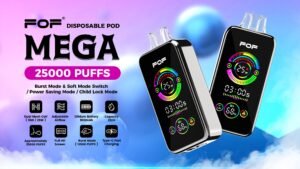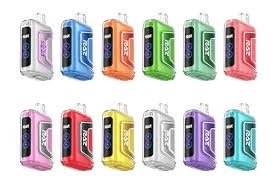Worried about the environmental impact of disposable vapes? As someone who's manufactured millions of these devices, I've witnessed the industry's heavy reliance on plastic firsthand—and the growing concerns from both consumers and regulators about the waste they create.
Most disposable e-cigarettes use significant amounts of plastic in their construction. While some newer models incorporate aluminum, silicone, or biodegradable materials for certain components, the outer casing, mouthpiece, and internal structural elements are predominantly made from various types of plastic polymers for cost, durability, and manufacturing efficiency.
 Disposable Vape Materials Comparison
Disposable Vape Materials Comparison
Having spent years in vape manufacturing, from working on factory floors to now running my own production facility, I've developed intimate knowledge of how these devices are constructed. When distributing partners like Tommy visit from Malaysia, their concerns increasingly include questions about materials and sustainability. This shift in industry conversation has been dramatic, especially in the past few years, as environmental issues have moved from afterthoughts to central business considerations.
Are Disposable Vapes Made of Plastic?
Concerned about the growing plastic waste from the vaping industry? Wondering if those colorful devices that seem to be everywhere are contributing to our environmental problems? Let me share what I know from the production side.
Yes, the majority of disposable vapes are predominantly made of plastic. Typically, the outer shell is polycarbonate or ABS plastic, the mouthpiece is food-grade PC or PP plastic, and internal components use various polymer materials. While some brands incorporate metal elements like aluminum for the body or certain internal components, plastic remains the dominant material.
 Plastic Components in Disposable Vapes
Plastic Components in Disposable Vapes
When I walk through our manufacturing facility, plastic components are everywhere. The reality of disposable vape construction becomes clear when you see how these devices are assembled:
Primary Materials Used in Typical Disposable Vapes
The construction of standard disposables typically includes:
- Outer casing/shell: Generally made from ABS (Acrylonitrile Butadiene Styrene[^1]) or PC (Polycarbonate) plastic, selected for durability, appearance, and cost-effectiveness
- Mouthpiece: Usually food-grade PP (Polypropylene[^2]) or PC plastic for safety and comfort
- Internal structural components: Various plastic polymers for insulation and structure
- Tank/reservoir: Often medical-grade plastic, PET (Polyethylene Terephthalate[^3]), or glass in premium models
- Electronic housing: Plastic encasements protecting circuit boards and sensors
I remember when vape distributors first toured our production line, he was surprised by the sheer volume of plastic pellets being fed into our injection molding machines. Each disposable vape can contain 5-10 grams of various plastics, which adds up quickly when you consider the millions produced globally each month.
Metal Components in Disposable Vapes
While predominantly plastic, disposables do contain some metal elements:
- Battery: Contains lithium, copper, aluminum, and other metals
- Coil/heating element: Usually kanthal (FeCrAl alloy), nichrome, or stainless steel
- Connections and contacts: Small copper, zinc, or brass components
- Exterior shells (premium models): Some higher-end disposables use aluminum casings
In our factory, we've experimented with increasing the metal content in our designs, particularly using aluminum shells instead of plastic. While this improves durability and recyclability, it adds complexity to the manufacturing process and increases costs by 15-30%, which many mass-market brands are unwilling to absorb.
Material Distribution by Weight
In a typical mid-range disposable vape, the material distribution by weight is approximately:
- Plastics: 35-50%
- Battery: 30-40%
- E-liquid: 10-15%
- Metal components: 5-10%
- Circuit board and electronics: 2-5%
This breakdown varies based on design, but plastics consistently make up the largest portion of the physical device. When I discuss product development with Tommy for his Malaysian market, we often talk about how different markets are becoming more sensitive to this high plastic content, especially in regions with growing environmental consciousness.
The industry is slowly responding to these concerns, but the transition away from plastic-dominant designs faces significant hurdles in terms of cost, manufacturing complexity, and consumer price sensitivity. Currently, plastic remains the go-to material for the vast majority of disposable vape manufacturers worldwide.
Is There a Difference Between E-Cigarettes and Vapes?
Confused by the various terms used in the vaping industry? Wondering if "e-cigarettes" and "vapes" refer to different products? Let me clear up this common confusion with insights from my years in manufacturing.
While often used interchangeably, subtle differences exist between the terms. "E-cigarette" typically refers to devices designed to mimic traditional cigarettes in appearance and experience, while "vape" is a broader term encompassing all electronic nicotine delivery systems, including larger mod devices, pod systems, and disposables with diverse designs and functionalities.
 E-Cigarette vs Vape Device Comparison
E-Cigarette vs Vape Device Comparison
Having produced virtually every type of vaping device over my career, I've witnessed how these terms have evolved alongside the technology. The distinctions have blurred over time, but understanding the nuances helps consumers navigate the market:
Historical Evolution of Terminology
The naming conventions reflect the evolution of the technology:
- First generation (2003-2010): Originally called "electronic cigarettes" or "e-cigarettes," these early devices physically resembled cigarettes (often called "cigalikes") and were marketed primarily as cigarette alternatives
- Second generation (2010-2014): As designs moved away from cigarette appearance toward "vape pens," terminology began shifting toward "vapes" and "vaping devices"
- Current market (2015-present): "Vape" has become the dominant umbrella term, with "e-cigarette" sometimes used for specific cigarette-like products or in regulatory contexts
I remember when our factory first transitioned from producing only cigalikes to manufacturing vape pens around 2011. Our marketing materials struggled with the terminology, as the industry hadn't yet settled on standard descriptions.
Technical Distinctions
While the terms overlap, they can imply different technical characteristics:
- E-cigarettes (narrow definition)[^4]: Lower-powered devices (typically 1-4.5W), higher nicotine concentrations, mouth-to-lung draw similar to smoking
- Vapes (broader category)[^5]: Includes everything from disposable pods to high-powered box mods (5-200W), variable nicotine levels, and diverse inhalation styles
When working with distributors like Tommy, I find that regional preferences influence terminology[^6]. In Asia, "vape" has become the standard term, while in some European markets, "e-cigarette" remains common in both conversation and regulation.
Marketing and Regulatory Context
How the terms are used often depends on context:
- Marketing: "Vape" tends to be preferred for consumer-facing materials as it distances the products from traditional cigarettes
- Regulatory: Government agencies and health organizations often use "e-cigarette" as the formal classification term
- Consumer usage: Tends to vary by region and demographic, with younger users favoring "vape" and older former smokers sometimes preferring "e-cigarette"
When Tommy places orders for his Malaysian distribution business, our contracts formally list products as "electronic cigarettes" for regulatory compliance, but all our consumer packaging uses variations of "vape" terminology.
In practical terms, both "e-cigarettes" and "vapes" refer to the same category of nicotine delivery technology. The distinction matters more for regulatory compliance and marketing positioning than for consumers trying to understand the products. The more important distinctions lie in the specific device types (disposable, pod system, mod) and how they function.
What Is a Disposable Vape Made Of?
Ever wondered what's actually inside that disposable vape device? Curious about the materials used to create these increasingly popular products? Let me share my manufacturing insights on what goes into making them.
A typical disposable vape consists of a lithium-ion battery (15-35% of total weight), an integrated circuit board with sensors, a metal heating coil (usually kanthal or nichrome), cotton or ceramic wicking material, e-liquid with propylene glycol, vegetable glycerin, flavorings and nicotine, and a plastic shell typically made from ABS or polycarbonate plastic.
 "Disposable Vape Components Breakdown")
"Disposable Vape Components Breakdown")
Having overseen the production of millions of disposable vapes, I can provide a comprehensive breakdown of their components. These seemingly simple devices actually contain a surprising variety of materials:
Core Electronic Components
The functional heart of any disposable vape includes:
- Battery: Lithium-ion batteries[^7] ranging from 280mAh to 1000mAh depending on the device size
- Microchip/integrated circuit: Controls power delivery and safety features[^8]
- Sensors: Usually a pressure/vacuum sensor that detects when the user inhales
- LED indicator: Typically made from small LED bulbs and light diffusing materials
- Connecting wires and contacts: Small gauge copper wiring and connection points
When vape distributors visits our production facility, he's always particularly interested in the batteries we use, as they represent both the most expensive component and the biggest potential safety concern. We source ours from specialized battery manufacturers[^9] who meet strict quality standards.
Heating System Materials
The vaporization system consists of:
- Coil: Usually made from resistance wire like kanthal (iron-chromium-aluminum alloy) or nichrome (nickel-chromium)
- Wicking material: Most commonly organic cotton, though some premium devices use ceramic, silica, or other specialized materials
- Housing/chamber: Generally made from food-grade plastic or sometimes metal in higher-end devices
I've spent countless hours testing different coil designs and materials, finding that small variations can dramatically affect vapor production, flavor delivery, and battery efficiency. The heating system is where the real engineering of a vape device happens.
E-Liquid Components
The consumable liquid contains:
- Propylene Glycol (PG): A thin, nearly tasteless carrier liquid that produces throat hit
- Vegetable Glycerin (VG): A thicker, slightly sweet base that produces visible vapor
- Flavorings: A proprietary mix of food-grade flavoring compounds
- Nicotine: Usually synthetic nicotine or nicotine extracted from tobacco plants, in concentrations ranging from 0-5% (0-50mg/ml)
- Acids (in salt nicotine formulations): Benzoic acid or other acids used to create nicotine salt formulations
E-liquid quality varies dramatically across the industry. In our facility, we use pharmaceutical-grade base ingredients and work with specialized flavor houses to develop our formulations, but some manufacturers cut corners with lower-grade materials.
External Housing and Structural Elements
The visible exterior includes:
- Main body/shell: Typically ABS (Acrylonitrile Butadiene Styrene) or PC (Polycarbonate) plastic
- Mouthpiece: Usually PP (Polypropylene) or PC food-grade plastic
- Airflow components: Small plastic or silicone parts that control air intake
- Decorative elements: Paint, printing, labels, or wraps on the exterior
Early in my manufacturing career, I worked primarily with simple plastic shells. Today, our premium lines include devices with aluminum exteriors, soft-touch coatings, and even wood or fabric accents for higher-end products.
Material Sourcing Considerations
Material quality varies significantly across the industry:
- Budget devices: Often use recycled plastics for non-contact parts and lower-grade electronic components
- Mid-range devices: Use virgin (non-recycled) plastics and standard-quality electronics
- Premium devices: Employ medical-grade plastics, higher-purity metals, and superior electronic components
When consulting with Tommy about product development for his distribution business, we often discuss the trade-offs between material quality and final retail price. The difference between a disposable that retails for $8 versus $15 largely comes down to these material choices and their impact on performance and reliability.
Understanding the materials in disposable vapes helps explain both their cost structure and why proper disposal is so important—these devices contain a complex mix of plastics, metals, and electronic components that ideally should be properly recycled rather than sent to landfills.
What Is the Most Environmentally Friendly Way to Vape?
Looking for sustainable vaping options that minimize environmental impact? Concerned about the waste from disposable devices? Let me share my manufacturing experience on the greenest approaches to vaping.
The most environmentally friendly vaping method is using a refillable, rebuildable device with long-lasting components. Refillable pod systems generate 90% less waste than disposables, while advanced rebuildable devices reduce waste by up to 95%. Choosing products with recyclable materials, buying e-liquid in larger bottles, and properly recycling spent components further reduces environmental impact.
 Environmental Impact Comparison of Vaping Methods
Environmental Impact Comparison of Vaping Methods
Through my years in vape manufacturing, I've developed a clear understanding of the environmental footprint of different vaping methods. Here's how various approaches compare:
Reusable Systems vs. Disposables
The environmental difference between system types is dramatic:
- Disposable e-cigarettes[^10]: Generate approximately 10-20g of waste per device, with the entire unit discarded after use
- Pod systems[^11]: Generate about 1-2g of waste per pod replacement (90% reduction vs. disposables)
- Rebuildable devices[^12]: Generate minimal ongoing waste, primarily from cotton and small wire pieces
In our factory, I've calculated that the materials used to make one disposable vape could instead produce enough components for a refillable device that would deliver the equivalent of 10-30 disposables when accounting for replacement coils and e-liquid.
Hierarchical Environmental Impact
From worst to best environmental options:
- Single-use disposables: Highest waste generation, containing batteries and electronics that often end up in landfills
- Prefilled pod systems: Reduced waste compared to disposables, but still create regular plastic waste from pod cartridges
- Refillable pod systems: Significantly lower waste, only requiring occasional pod replacement (typically every 2-4 weeks)
- Tank systems with replaceable coils: Very low ongoing waste, with only small coil units needing regular replacement
- Rebuildable atomizers (RDAs, RTAs): Minimal waste, requiring only cotton and small amounts of wire to be replaced
When Tommy asks about environmentally conscious options for his Malaysian distribution business, I always emphasize the dramatic difference in waste generation between these categories. A single customer switching from disposables to a rebuildable tank can reduce their vaping-related waste by over 95% in a year.
E-Liquid Packaging Considerations
How you purchase e-liquid also affects environmental impact:
- Individual disposables: Least efficient, with small amounts of e-liquid in non-recyclable integrated tanks
- Prefilled pods: Slightly better, but still creates significant packaging waste
- 10ml bottles: Common size but creates more plastic waste per ml than larger options
- 30ml-60ml bottles: Moderately efficient packaging-to-product ratio
- 100ml+ bottles: Most efficient packaging-to-product ratio, minimizing plastic waste
Our manufacturing data shows that selling e-liquid in 100ml bottles uses approximately 70% less plastic per ml of liquid compared to 10ml bottles, a significant reduction in packaging waste.
Battery Selection and Longevity
Battery choices significantly impact sustainability:
- Internal batteries: Look for higher quality cells rated for more charge cycles (1000+ vs. 300-500 in budget devices)
- Replaceable batteries: Allow for battery replacement without discarding the entire device
- Recyclability: Choose devices from manufacturers with battery recycling programs
In our premium device lines, we use batteries rated for 1000+ charge cycles, effectively tripling the lifespan compared to budget options with cheaper cells that degrade after 300-500 cycles.
Material Selection Factors
Some materials are more environmentally sound than others:
- Metal vs. plastic construction: Metal components are more likely to be recycled and generally last longer
- Biodegradable options: Some manufacturers are experimenting with biodegradable mouthpieces and certain components
- Modular design: Products designed for easy repair and part replacement extend usable life
When I work on new device designs, I've started incorporating more recyclable materials and focusing on modular construction that allows for component replacement rather than whole-device disposal when one part fails.
The environmental impact difference between disposable and reusable vaping systems is substantial. By choosing a quality refillable device, using larger e-liquid bottles, and properly recycling components, vapers can reduce their environmental footprint by 90% or more compared to using disposables.
Conclusion
After years in the vape manufacturing industry, I can confirm that most disposable e-cigarettes rely heavily on plastic. While the industry is making small steps toward more sustainable options, reusable systems remain vastly more environmentally friendly. For distributors like Hustler Mega Vape and environmentally conscious consumers, understanding these material realities helps make more informed choices about which products to stock, sell, and use.
[^1]: Explore the properties and applications of ABS to understand why it's favored in disposable products.
[^2]: Learn about the advantages of Polypropylene, especially in safety and comfort for consumer products.
[^3]: Discover the applications of PET in medical-grade products and its importance in safety and quality.
[^4]: Understanding the specific features of E-cigarettes can help you make informed choices about vaping products.
[^5]: Exploring the differences can enhance your knowledge of vaping options and help you choose the right device for your needs.
[^6]: Discovering how terminology varies by region can provide insights into market trends and consumer behavior in vaping.
[^7]: Explore this link to understand why Lithium-ion batteries are crucial for vape performance and safety.
[^8]: Learn about essential safety features that ensure a secure vaping experience and protect users.
[^9]: Discover tips on selecting trustworthy battery manufacturers to ensure quality and safety in vaping products.
[^10]: Understanding the environmental impacts of disposable e-cigarettes can help consumers make informed choices about vaping products.
[^11]: Exploring how pod systems minimize waste can highlight more sustainable vaping options for eco-conscious users.
[^12]: Learning about rebuildable devices can reveal their advantages in sustainability and cost-effectiveness for vapers.





